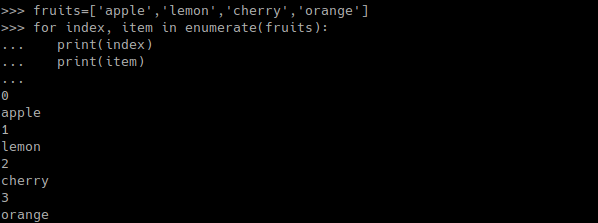Python为程序员提供了易于使用的函数和机制。在处理集合或列表类型时,我们通常需要一些方法来枚举它们。 enumerate() 函数用于从给定的列表或集合创建iterable或enumerable类型。在这个操作之后,我们可以使用创建的对象来迭代 for 或 while 结构。
null
列举
我们将从一个简单的枚举示例开始。我们将提供一份名为 fruits 到 enumerate() 函数,该函数将用元组格式的索引编号列表更改列表。
fruits=['apple','lemon','cherry','orange'] list(enumerate(fruits)) #This will print#[(0, 'apple'), (1, 'lemon'), (2, 'cherry'), (3, 'orange')]
用计数器枚举
我们可以通过指定 start 参数如下。我们可以在下面的例子中看到 start 索引将为 1 不违约 .
fruits=['apple','lemon','cherry','orange'] list(enumerate(fruits,start=1)) #This will print # [(1, 'apple'), (2, 'lemon'), (3, 'cherry'), (4, 'orange')]
获取索引值
作为 enumerate() 函数以元组格式返回,我们可以将索引和项放入单独的变量中,并在下面这样的循环中使用它们。
fruits=['apple','lemon','cherry','orange'] for index, item in enumerate(fruits): print(index) print(item)
相关文章: 如何循环和迭代Python字典?
© 版权声明
文章版权归作者所有,未经允许请勿转载。
THE END


![关于”PostgreSQL错误:关系[表]不存在“问题的原因和解决方案-yiteyi-C++库](https://www.yiteyi.com/wp-content/themes/zibll/img/thumbnail.svg)




